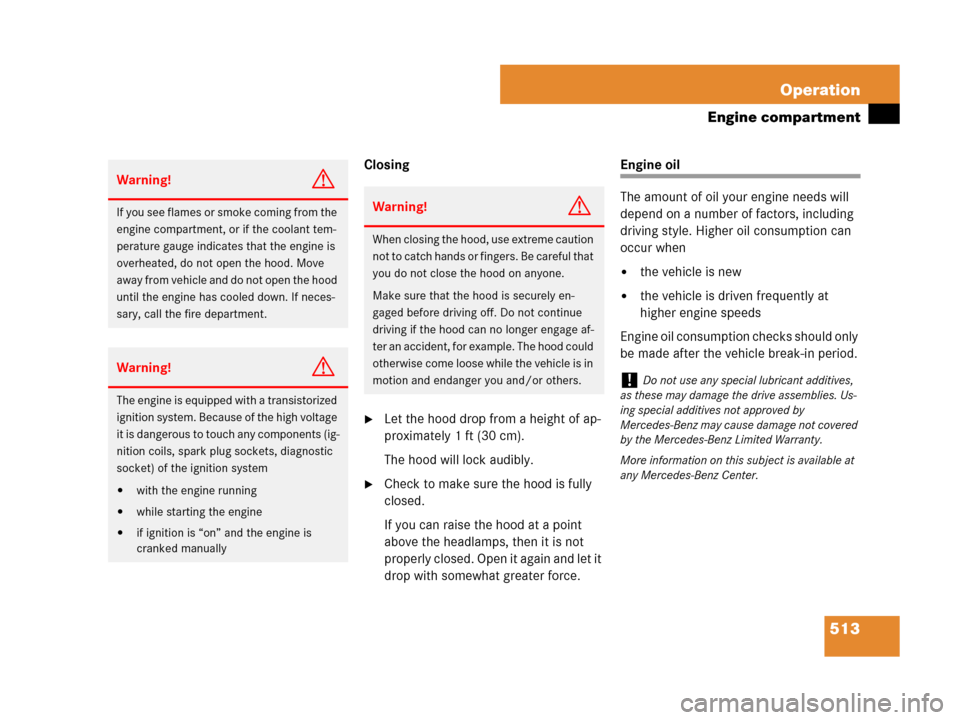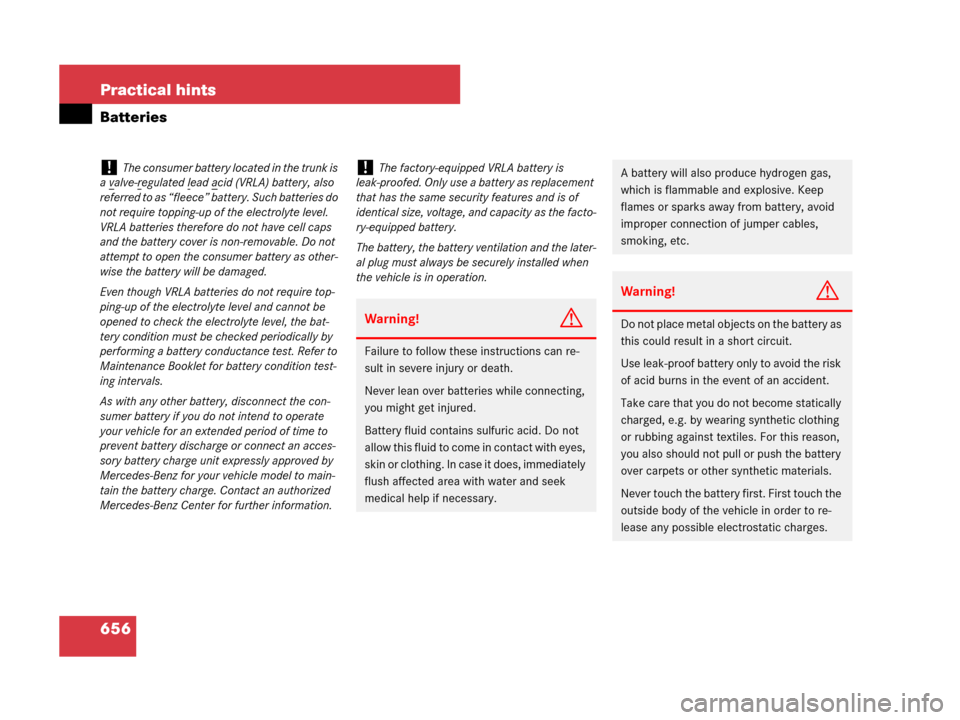Page 516 of 723

513 Operation
Engine compartment
Closing
�Let the hood drop from a height of ap-
proximately 1 ft (30 cm).
The hood will lock audibly.
�Check to make sure the hood is fully
closed.
If you can raise the hood at a point
above the headlamps, then it is not
properly closed. Open it again and let it
drop with somewhat greater force.
Engine oil
The amount of oil your engine needs will
depend on a number of factors, including
driving style. Higher oil consumption can
occur when
�the vehicle is new
�the vehicle is driven frequently at
higher engine speeds
Engine oil consumption checks should only
be made after the vehicle break-in period.
Warning!G
If you see flames or smoke coming from the
engine compartment, or if the coolant tem-
perature gauge indicates that the engine is
overheated, do not open the hood. Move
away from vehicle and do not open the hood
until the engine has cooled down. If neces-
sary, call the fire department.
Warning!G
The engine is equipped with a transistorized
ignition system. Because of the high voltage
it is dangerous to touch any components (ig-
nition coils, spark plug sockets, diagnostic
socket) of the ignition system
�with the engine running
�while starting the engine
�if ignition is “on” and the engine is
cranked manually
Warning!G
When closing the hood, use extreme caution
not to catch hands or fingers. Be careful that
you do not close the hood on anyone.
Make sure that the hood is securely en-
gaged before driving off. Do not continue
driving if the hood can no longer engage af-
ter an accident, for example. The hood could
otherwise come loose while the vehicle is in
motion and endanger you and/or others.
!Do not use any special lubricant additives,
as these may damage the drive assemblies. Us-
ing special additives not approved by
Mercedes-Benz may cause damage not covered
by the Mercedes-Benz Limited Warranty.
More information on this subject is available at
any Mercedes-Benz Center.
Page 659 of 723

656 Practical hints
Batteries
!The consumer battery located in the trunk is
a v
alve-regulated lead acid (VRLA) battery, also
referred to as “fleece” battery. Such batteries do
not require topping-up of the electrolyte level.
VRLA batteries therefore do not have cell caps
and the battery cover is non-removable. Do not
attempt to open the consumer battery as other-
wise the battery will be damaged.
Even though VRLA batteries do not require top-
ping-up of the electrolyte level and cannot be
opened to check the electrolyte level, the bat-
tery condition must be checked periodically by
performing a battery conductance test. Refer to
Maintenance Booklet for battery condition test-
ing intervals.
As with any other battery, disconnect the con-
sumer battery if you do not intend to operate
your vehicle for an extended period of time to
prevent battery discharge or connect an acces-
sory battery charge unit expressly approved by
Mercedes-Benz for your vehicle model to main-
tain the battery charge. Contact an authorized
Mercedes-Benz Center for further information.!The factory-equipped VRLA battery is
leak-proofed. Only use a battery as replacement
that has the same security features and is of
identical size, voltage, and capacity as the facto-
ry-equipped battery.
The battery, the battery ventilation and the later-
al plug must always be securely installed when
the vehicle is in operation.
Warning!G
Failure to follow these instructions can re-
sult in severe injury or death.
Never lean over batteries while connecting,
you might get injured.
Battery fluid contains sulfuric acid. Do not
allow this fluid to come in contact with eyes,
skin or clothing. In case it does, immediately
flush affected area with water and seek
medical help if necessary.
A battery will also produce hydrogen gas,
which is flammable and explosive. Keep
flames or sparks away from battery, avoid
improper connection of jumper cables,
smoking, etc.
Warning!G
Do not place metal objects on the battery as
this could result in a short circuit.
Use leak-proof battery only to avoid the risk
of acid burns in the event of an accident.
Take care that you do not become statically
charged, e.g. by wearing synthetic clothing
or rubbing against textiles. For this reason,
you also should not pull or push the battery
over carpets or other synthetic materials.
Never touch the battery first. First touch the
outside body of the vehicle in order to re-
lease any possible electrostatic charges.
Page 685 of 723
682 Technical data
Electrical system
ModelCL 550CL 600
Generator (alternator)14 V/180 A14 V/220 A
Starter motor12 V/1.7 kW12 V/1.7 kW
Starter battery12 V/35 Ah12 V/35 Ah
Electrical consumer battery12 V/95 Ah12 V/95 Ah
Spark plugsNGK PLKR 6A
Bosch Y 7 MPP 33NGK IFR 6Q-G
Electrode gap0.031 in (0.8 mm)0.028 in (0.7 mm)
Tightening torque15 – 18 lb-ft (20 – 25 Nm)18 – 22 lb-ft (25 – 30 Nm)